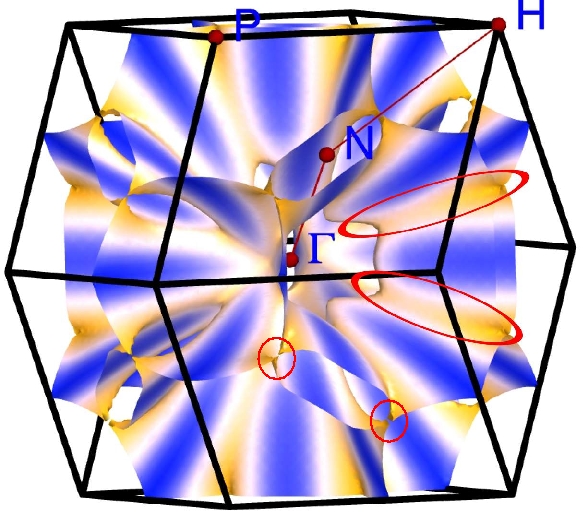BioSketch
Courses
Research
Featured Research
HighViz Activities
Recent Service
Group Members
Earlier Research
Research Support
Publications
Presentations
Honors
Physics Links
2004's Model
"The modern age has a false sense of security because of the great
mass of data at its disposal. But the valid issue is the extent to
which people know how to form and master the material at their disposal."
Wolfgang von Goethe, 1832.
H3 S Fermi surface.
Illustration of the topological change of the constant energy
surfaces in H3 S that provides the van Hove singularities
that makes this simple compound the current highest temperature
superconductor. Red circles indicate touching surfaces, red ellipses
outline low velocity regions of intersecting surfaces.
Below: animation (click to see) of constant energy surfaces.
Dynamic view of the constant electronic energy surfaces in
momentum spade of the 200K
high temperature superconductor H3 S
as the topological changes occur through the van Hove points.
Our group has performed investigations into the impact of these
van Hove singularities on the properties of H3 S.
<--!
-->
Description of the MnO Mott transition from insulator to metal
at one million atmospheres pressure. We extended and applied the
dynamical mean field theory method to obtain the magnetic
and volume collapse transition.
It was found that Hund's rule exchange processes are important for
obtaining the correct transformation pressure. Moreover, residual
magnetism was obtained from the calculation, in agreement with
spectroscopic data. The figure provides the current knowledge on
the pressure-temperature phase diagram of MnO.
Dynamics of Superconducting H3 S
In 2014 Eliashberg theory (carried out in China)
predicted that hydrogen sulfide
H3 S would become a super-high temperature superconductor at
the very high pressure of 1.6-2 million atmospheres. In 2005 Eremets' group in
Germany measured and found superconductivity up to 203K at 1.6 million
asmospheres, the same amazing result. One of our contributions
has been to perform an ab initio molecular dynamics simulation of
atomic vibrations of H3S at a temperature of 200 K and the experimental
pressure. The hydrogen vibration amplitudes are very large; in a
metal with normal (heavy) nuclei, the vibration would hardly be visible.
Note: this video (click the title) may be slow to load.
Fermi surface & Nesting function.
Superconductivity and lattice instability in compressed lithium
from Fermi surface hot spots.
Lithium superconducts up to 20K at high pressure, before
structural phase transitions (lattice instabilities) occur,
limiting higher Tc .





